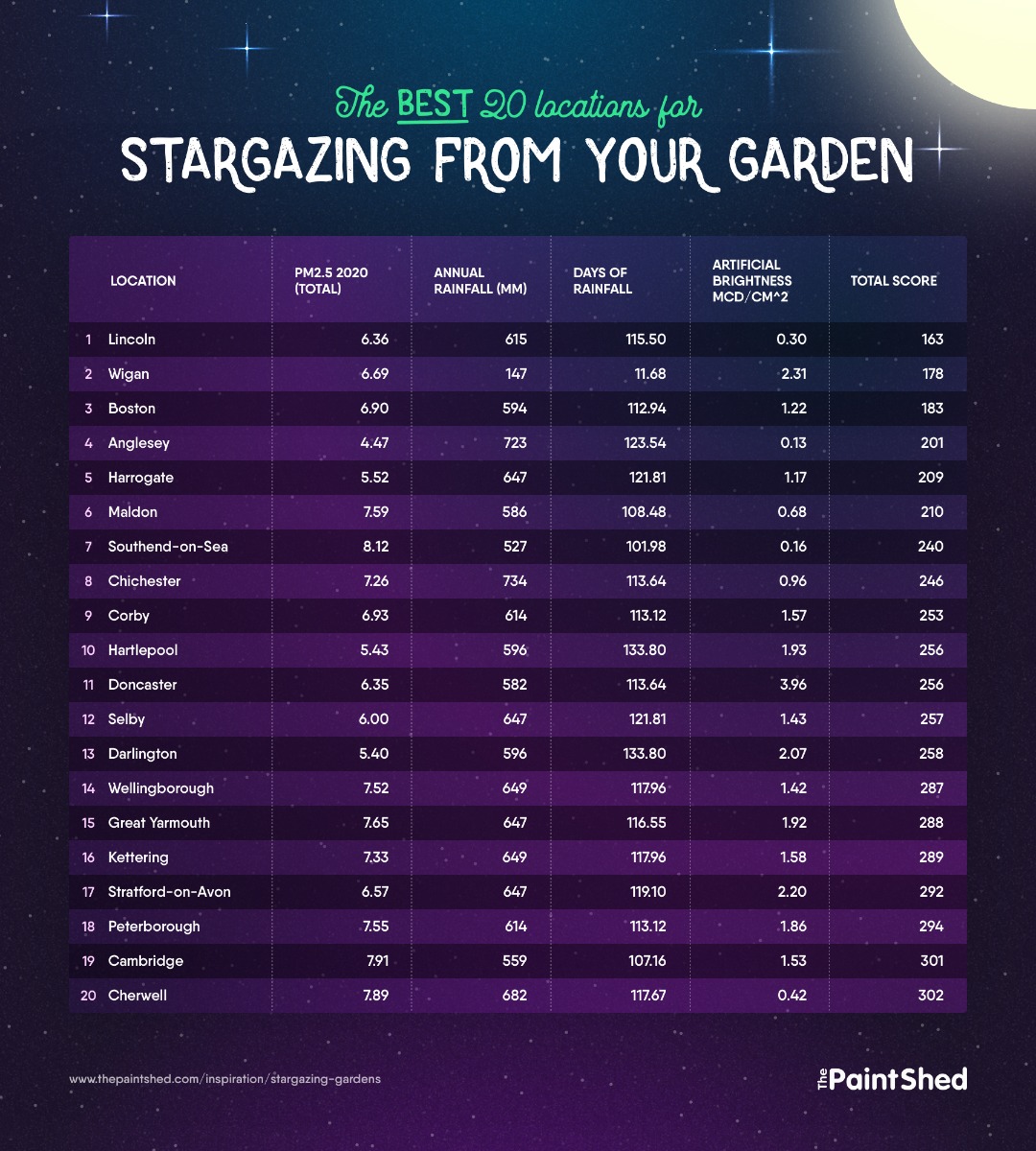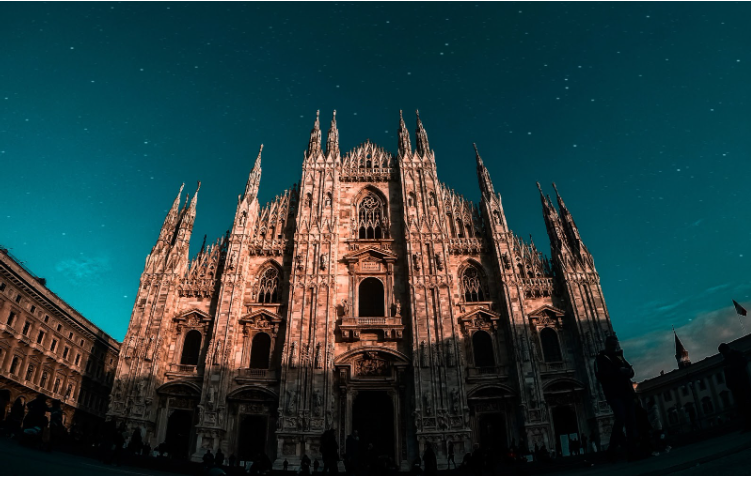UK's Top Spots for Garden Stargazing

You don’t have to go far to experience the wonders of the universe - sometimes just outside your back door is far enough to see incredible things in the sky… if you live in the right places that is.
We at The Paint Shed have recently conducted a study to discover the best places to live in the UK if you want to see the stars from your own garden. We ranked a number of boroughs, towns and cities against factors such as:
- Number of private gardens per 10k people
- Air pollution: PM2.5 levels
- Artificial brightness: Millicandela per cm² (mcd/cm²)
- Average annual rainfall: mm per year
- Average number of days of rain per year
Each figure was ranked against the other 182 locations’ figures to give a score between 1 and 181; the location with the lowest overall rating was deemed the best place to live to see the stars.
The top 25 locations to see the stars from your garden


Lincoln is the location with the BEST stargazing gardens in the UK

Out of all 182 locations, Lincoln in the East Midlands had the lowest overall score, making it the best location in the UK for astronomy enthusiasts to live. Despite not being the top location for any individual factor, it scored low across the board, with it coming in third for its artificial brightness level.
The second place was Wigan, in the North West, which boasts the least amount of rain of all locations as well as the least amount of days of rainfall too.
Third place was another East Midlands location, Boston. This market town, also in Lincolnshire, again did not come in at the top for any individual factor but the collective score was low enough to rank it third.
The bottom 25 locations to see the stars from your garden

Rank | Town/city/ borough | Garden rank | Air pollution rank | Total score |
1 | Leeds | 121 | 104 | 725 |
2 | Manchester | 154 | 89 | 724 |
3 | Croydon | 151 | 163 | 718 |
4 | Wolverhampton | 116 | 84 | 709 |
5 | Bradford | 147 | 75 | 704 |
6 | Birmingham | 155 | 140 | 702 |
7 | Cardiff | 142 | 95 | 700 |
8 | Southwark | 177 | 177 | 695 |
9 | Hackney | 178 | 178 | 692 |
10 | Camden | 180 | 168 | 683 |
11 | Islington | 169 | 175 | 682 |
12 | Bromley | 141 | 148 | 679 |
13 | Westminster | 163 | 174 | 677 |
14 | Sutton | 144 | 156 | 671 |
15 | Waltham Forest | 159 | 171 | 650 |
16 | Walsall | 128 | 131 | 646 |
17 | Salford | 101 | 78 | 643 |
18 | Haringey | 143 | 167 | 632 |
19 | Bristol, City of | 139 | 129 | 629 |
20 | Oldham | 111 | 82 | 626 |
21 | Glasgow City | 94 | 7 | 622 |
23 | Liverpool | 64 | 113 | 614 |
22 | Barnet | 172 | 150 | 618 |
23 | Southampton | 148 | 142 | 614 |
25 | Bolton | 72 | 72 | 613 |
Leeds is the location with the WORST stargazing gardens in the UK

When it came to the places in the UK with the worst gardens to stargaze from, Yorkshire city Leeds took the top spot, scoring especially high for factors such as annual rainfall, days of rainfall and artificial brightness.
Another northern city took second place. Manchester scored high for artificial brightness, days of rainfall and number of private residences with gardens per 10k people, possibly due to the higher number of flats/apartments in this metropolitan area.
In third place, and perhaps not surprisingly, was the London borough of Croydon; its air pollution rank was the 19th highest in the whole list, but not the highest amongst the London boroughs.
Best and worst London boroughs for stargazing

With a nickname like “the big smoke”, it is no surprise that stargazing isn’t an activity that many Londoners get to enjoy at home. However, not all boroughs are made equal and where you live in London can actually affect your chances of seeing the stars.
Rank | London borough | Garden rank | Air pollution rank | Total score |
1 | Kensington and Chelsea | 4 | 176 | 415 |
2 | Bexley | 146 | 162 | 447 |
3 | Havering | 136 | 149 | 452 |
4 | Hammersmith and Fulham | 58 | 170 | 460 |
5 | Lewisham | 135 | 173 | 474 |
8 | Barking and Dagenham | 175 | 172 | 505 |
9 | Greenwich | 162 | 165 | 507 |
9 | Kingston upon Thames | 164 | 151 | 507 |
11 | Merton | 140 | 166 | 510 |
12 | Lambeth | 160 | 179 | 525 |
13 | Hounslow | 171 | 154 | 535 |
14 | Ealing | 158 | 158 | 538 |
15 | Hillingdon | 165 | 146 | 540 |
16 | Tower Hamlets | 181 | 180 | 545 |
17 | City of London | 182 | 181 | 552 |
18 | Wandsworth | 161 | 169 | 558 |
19 | Brent | 173 | 161 | 561 |
20 | Newham | 179 | 182 | 571 |
21 | Harrow | 170 | 147 | 588 |
22 | Enfield | 167 | 159 | 591 |
23 | Barnet | 172 | 150 | 618 |
24 | Haringey | 143 | 167 | 632 |
25 | Waltham Forest | 159 | 171 | 650 |
26 | Sutton | 144 | 156 | 671 |
27 | Westminster | 163 | 174 | 677 |
28 | Bromley | 141 | 148 | 679 |
29 | Islington | 169 | 175 | 682 |
30 | Camden | 180 | 168 | 683 |
31 | Hackney | 178 | 178 | 692 |
32 | Southwark | 177 | 177 | 695 |
33 | Croydon | 151 | 163 | 718 |
Kensington and Chelsea came out on top out of the London Boroughs, with residents here being the most likely to see the stars from their own gardens. Baxley came in second and Havering in third. The two factors that let these - and many of the other - London boroughs down are the air pollution figures and the artificial brightness levels.
Fine particulate matter (PM2.5) is an air pollutant that is a concern for people's health when levels in air are high. PM2.5 are tiny particles in the air that reduce visibility and cause the air to appear hazy when levels are elevated, which is why it can affect the visibility of the night sky.
In fact, the air pollution is so bad in most of London that the top 22 locations for the highest PM2.5 levels are all London Boroughs. The worst offender was Newham, with a PM2.5 level of 10.62, which is nearly triple the lowest figure from the list of locations (3.96 for Stirling in Scotland). Second was the City of London, which - considering the level of traffic wasn’t surprising - and third was Tower Hamlets.
The 20 London Boroughs with the worst air
Rank | London Borough | PM2.5 2020 (total) |
1 | Newham | 10.62 |
2 | City of London | 10.23 |
3 | Tower Hamlets | 10.23 |
4 | Lambeth | 10.16 |
5 | Hackney | 10.13 |
6 | Southwark | 10.12 |
7 | Kensington and Chelsea | 10.07 |
8 | Islington | 10.06 |
9 | Westminster | 10.06 |
10 | Lewisham | 10.02 |
11 | Barking and Dagenham | 10.00 |
12 | Waltham Forest | 9.99 |
13 | Hammersmith and Fulham | 9.93 |
14 | Wandsworth | 9.92 |
15 | Camden | 9.75 |
16 | Haringey | 9.74 |
17 | Merton | 9.73 |
18 | Greenwich | 9.70 |
19 | Redbridge | 9.70 |
20 | Croydon | 9.31 |
Special moons to look out for

- Strawberry Moon: 14 June (12.51pm)
- Buck Moon: 13 July (7.38pm)
- Sturgeon Moon: 12 August (2.36am)
- Corn/Harvest Moon: 10 September (10.59am)
- Hunter's Moon: 9 October (9.55pm)
- Beaver Moon: 8 November (11.02am)
- Cold Moon: 08 December (4.08am)
Next meteor showers to spot in your back garden

Delta Aquariids
Visible: 12 July - 23 August
Peak: 30 July
Alpha Capricornids
Visible: 3 July - 15 August
Peak: 30 July
Perseids
Visible: 17 July - 24 August
Peak: 12-13 August
Draconids
Visible: 6-10 October
Peak: 8-9 October
Orionids
Visible: 2 October - 7 November
Peak: 21-22 October
Northern Taurids
Visible: 20 October - 10 December
Peak: 12-13 November
Leonids
Visible: 6-30 November
Peak: 17-18 November
Geminids
Visible: 4-20 December
Peak: 14-15 December
Ursids
Visible: 17-26 December
Peak: 22-23 December
Quadrantids
Visible: 28 December 2022 to 12 January 2023
Peak: 4 January
How to set up your garden for stargazing

Want to increase your chances of having a better night sky viewing experience? Then you will need to adapt your garden. When it comes to stargazing the darker the better, this means if you are a true astronomy enthusiast choosing a dark fence paint or exterior paint if you have brick walls surrounding your garden, as darker colours will absorb any light and will stop as much reflection, making for a better stargazing experience.
The same applies for painted patios; if you have a white painted patio, you may want to consider a dark outdoor rug or painting the patio a darker shade.
Check out our range of garden paint to find the right paint for your exterior surfaces.
Methodology
Working from a list of UK locations we collected data for each factor and then ranked them from 1 to 182. Those scoring the lowest were deemed the best and those with the highest score the worst. The highest, and therefore worst, score a place could achieve was 910 (182x5).
Sources:
- Number of private gardens: ONS Access to gardens and public green space in Great Britain
- Air pollution: https://uk-air.defra.gov.uk/
- Artificial brightness: https://www.lightpollutionmap.info
- Average annual rainfall and Average number of days of rain per year: https://www.metoffice.gov.uk/research/climate/maps-and-data/uk-climate-averages
Due to weather stations not being available in every location, the closest suggested stations were always between 1-20 miles from the location stated.


